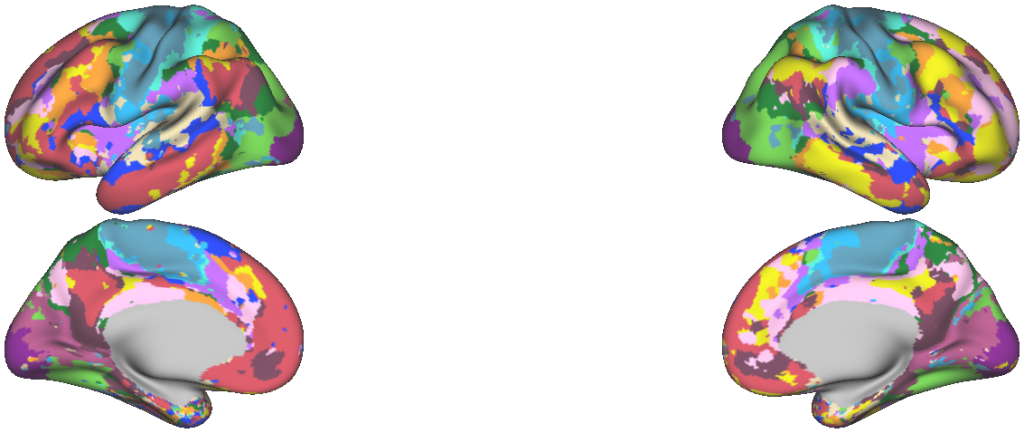FULL TITLE:
Side-by-Side Regions in Dorsolateral Prefrontal Cortex Estimated Within the Individual Respond Differentially to Domain-Specific and Domain-Flexible Processes
SPECIES:
Human
DESCRIPTION:
Parcellations, prefrontal regions of interest, and task contrast maps (in relation to network borders) for all subjects (N=9) are included here. Data for Subjects 3, 8 and 9 (shown in the paper figures) are in "DiNicolaSunBuckner_2023_CWv1p5.scene." Data for Subjects 1, 2, 4, 5, 6 and 7 are in "DiNicolaSunBuckner_2023_Supplemental_CWv1p5.scene." Lateral views from both hemispheres are shown for task contrast maps in relation to network borders (dorsally rotated for Subjects 3, 8 and 9 as in Figure 5 in the text). Medial views can be visualized by opening the scenes. The dorsal rotation shown in Figures 1 and 5 in the text (and task contrast maps in "DiNicolaSunBuckner_2023_CWv1p5.scene") and in Figure S3 uses custom orientation, setting "Rotate (X,Y,Z)" to 18.00, 45.00, 90.00. Figures were originally created using Connectome Workbench v1.3.2, with colors of PFC Regions updated here for compatibility with v1.5.0.
ABSTRACT:
A recurring debate concerns whether regions of primate prefrontal cortex (PFC) support domain-flexible or domain-specific processes. Here we tested the hypothesis using functional MRI (fMRI) that side-by-side PFC regions, within distinct parallel association networks, differentially support domain-flexible and domain-specialized processing. Individuals (N=9) were intensively sampled, and all effects were estimated within their own idiosyncratic anatomy. Within each individual, we identified PFC regions linked to distinct networks, including a dorsolateral PFC (DLPFC) region coupled to the medial temporal lobe (MTL) and an extended region associated with the canonical multiple-demand network. We further identified an inferior PFC region coupled to the language network. Exploration in separate task data, collected within the same individuals, revealed a robust functional triple dissociation. The DLPFC region linked to the MTL was recruited during remembering and imagining the future, distinct from juxtaposed regions that were modulated in a domain-flexible manner during working memory. The inferior PFC region linked to the language network was recruited during sentence processing. Detailed analysis of the trial-level responses further revealed that the DLPFC region linked to the MTL specifically tracked processes associated with scene construction. These results suggest that the DLPFC possesses a domain-specialized region that is small and easily confused with nearby (larger) regions associated with cognitive control. The newly described region is domain-specialized for functions traditionally associated with the MTL. We discuss the implications of these findings in relation to convergent anatomical analysis in the monkey.
PUBLICATION:
Journal of Neurophysiology
- DOI:
10.1152/jn.00277.2023
- Lauren M. DiNicola
- Wendy Sun
- Randy L. Buckner
- Department of Psychiatry, Massachusetts General Hospital, Charlestown, MA 02129, USA
- Athinoula A. Martinos Center for Biomedical Imaging, Massachusetts General Hospital (RLB)
- Harvard Medical School
- Department of Psychology, Center for Brain Science, Harvard University, Cambridge, MA 02138, USA
-
DiNicolaSunBuckner_2023_CWv1p5.scene
SCENES:- Figure1_Subject3_FullParcellation
- Figure1_Subject8_FullParcellation
- Figure1_Subject9_FullParcellation
- Figure1_Subject3_PFCRegions
- Figure1_Subject8_PFCRegions
- Figure1_Subject9_PFCRegions
- Figure5_Subject3_DN-A_SceneConstruction
- Figure5_Subject3_FPN-A_NBackLoadEffect
- Figure5_Subject3_LANG_SentenceProcessing
- Figure5_Subject8_DN-A_SceneConstruction
- Figure5_Subject8_FPN-A_NBackLoadEffect
- Figure5_Subject8_LANG_SentenceProcessing
- Figure5_Subject9_DN-A_SceneConstruction
- Figure5_Subject9_FPN-A_NBackLoadEffect
- Figure5_Subject9_LANG_SentenceProcessing
-
DiNicolaSunBuckner_2023_Supplemental_CWv1p5.scene
SCENES:- Subject1_FullParcellation
- Subject2_FullParcellation
- Subject4_FullParcellation
- Subject5_FullParcellation
- Subject6_FullParcellation
- Subject7_FullParcellation
- Subject1_PFCRegions
- Subject2_PFCRegions
- Subject4_PFCRegions
- Subject5_PFCRegions
- Subject6_PFCRegions
- Subject7_PFCRegions
- Subject1_DN-A_SceneConstruction
- Subject1_FPN-A_NBackLoadEffect
- Subject1_LANG_SentenceProcessing
- Subject2_DN-A_SceneConstruction
- Subject2_FPN-A_NBackLoadEffect
- Subject2_LANG_SentenceProcessing
- Subject4_DN-A_SceneConstruction
- Subject4_FPN-A_NBackLoadEffect
- Subject4_LANG_SentenceProcessing
- Subject5_DN-A_SceneConstruction
- Subject5_FPN-A_NBackLoadEffect
- Subject5_LANG_SentenceProcessing
- Subject6_DN-A_SceneConstruction
- Subject6_FPN-A_NBackLoadEffect
- Subject6_LANG_SentenceProcessing
- Subject7_DN-A_SceneConstruction
- Subject7_FPN-A_NBackLoadEffect
- Subject7_LANG_SentenceProcessing













































